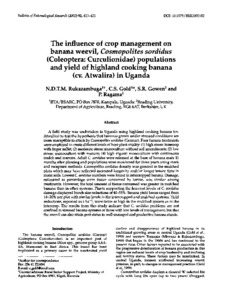| dc.contributor.author | Rukazambuga, N. |
| dc.contributor.author | Gold, C. |
| dc.contributor.author | Gowen, S. |
| dc.contributor.author | Ragama, P. |
| dc.date.accessioned | 2019-12-04T11:21:32Z |
| dc.date.available | 2019-12-04T11:21:32Z |
| dc.date.issued | 2002 |
| dc.identifier.citation | Rukazambuga, N., Gold, C., Gowen, S. & Ragama, P. (2002). The influence of crop management on banana weevil, Cosmopolites sordidus (Coleoptera: Curculionidae) populations and yield of highland cooking banana (cv. Atwalira) in Uganda. Bulletin of Entomological Research, 92(5), 413-421. |
| dc.identifier.issn | 0007-4853 |
| dc.identifier.uri | https://hdl.handle.net/20.500.12478/3810 |
| dc.description.abstract | A field study was undertaken in Uganda using highland cooking banana (cv. Atwalira) to test the hypothesis that bananas grown under stressed conditions are more susceptible to attack by Cosmopolites sordidus (Germar). Four banana treatments were employed to create different levels of host-plant vitality: (1) high stress: intercrop with finger millet; (2) moderate stress: monoculture without soil amendments; (3) low stress: monoculture with manure; (4) high vigour: monoculture with continuous mulch and manure. Adult C. sordidus were released at the base of banana mats 11 months after planting and populations were monitored for three years using mark and recapture methods. Cosmopolites sordidus density was greatest in the mulched plots which may have reflected increased longevity and/or longer tenure time in moist soils. Lowest C. sordidus numbers were found in intercropped banana. Damage, estimated as percentage corm tissue consumed by larvae, was similar among treatments. However, the total amount of tissue consumed was greater in mulched banana than in other systems. Plants supporting the heaviest levels of C. sordidus damage displayed bunch size reductions of 40–55%. Banana yield losses ranged from 14–20% per plot with similar levels in the intercropped and mulched systems. Yield reductions, reported as t ha-1, were twice as high in the mulched system as in the intercrop. The results from this study indicate that C. sordidus problems are not confined to stressed banana systems or those with low levels of management, but that the weevil can also attain pest status in well-managed and productive banana stands. |
| dc.description.sponsorship | Rockefeller Foundation |
| dc.language.iso | en |
| dc.subject | Crop Management |
| dc.subject | Banana Weevil |
| dc.subject | Cosmopolite Sordidus |
| dc.subject | Sucker |
| dc.title | The influence of crop management on banana weevil, Cosmopolites sordidus (Coleoptera: Curculionidae) populations and damage to highland cooking banana (cv. Atwalira) in Uganda |
| dc.type | Journal Article |
| dc.description.version | Peer Review |
| cg.contributor.affiliation | International Institute of Tropical Agriculture |
| cg.contributor.affiliation | University of Reading |
| cg.coverage.region | Africa |
| cg.coverage.region | East Africa |
| cg.coverage.country | Uganda |
| cg.isijournal | ISI Journal |
| cg.authorship.types | CGIAR and advanced research institute |
| cg.iitasubject | Tissue Culture |
| cg.iitasubject | Banana |
| cg.iitasubject | Pests Of Plants |
| cg.iitasubject | Genetic Improvement |
| cg.accessibilitystatus | Limited Access |
| local.dspaceid | 95965 |
| cg.identifier.doi | https://doi.org/10.1079/BER2002182 |

